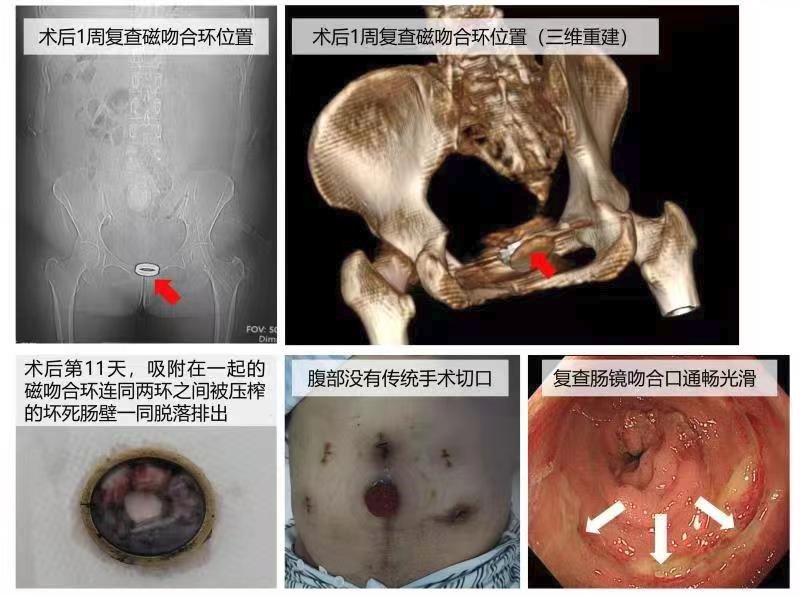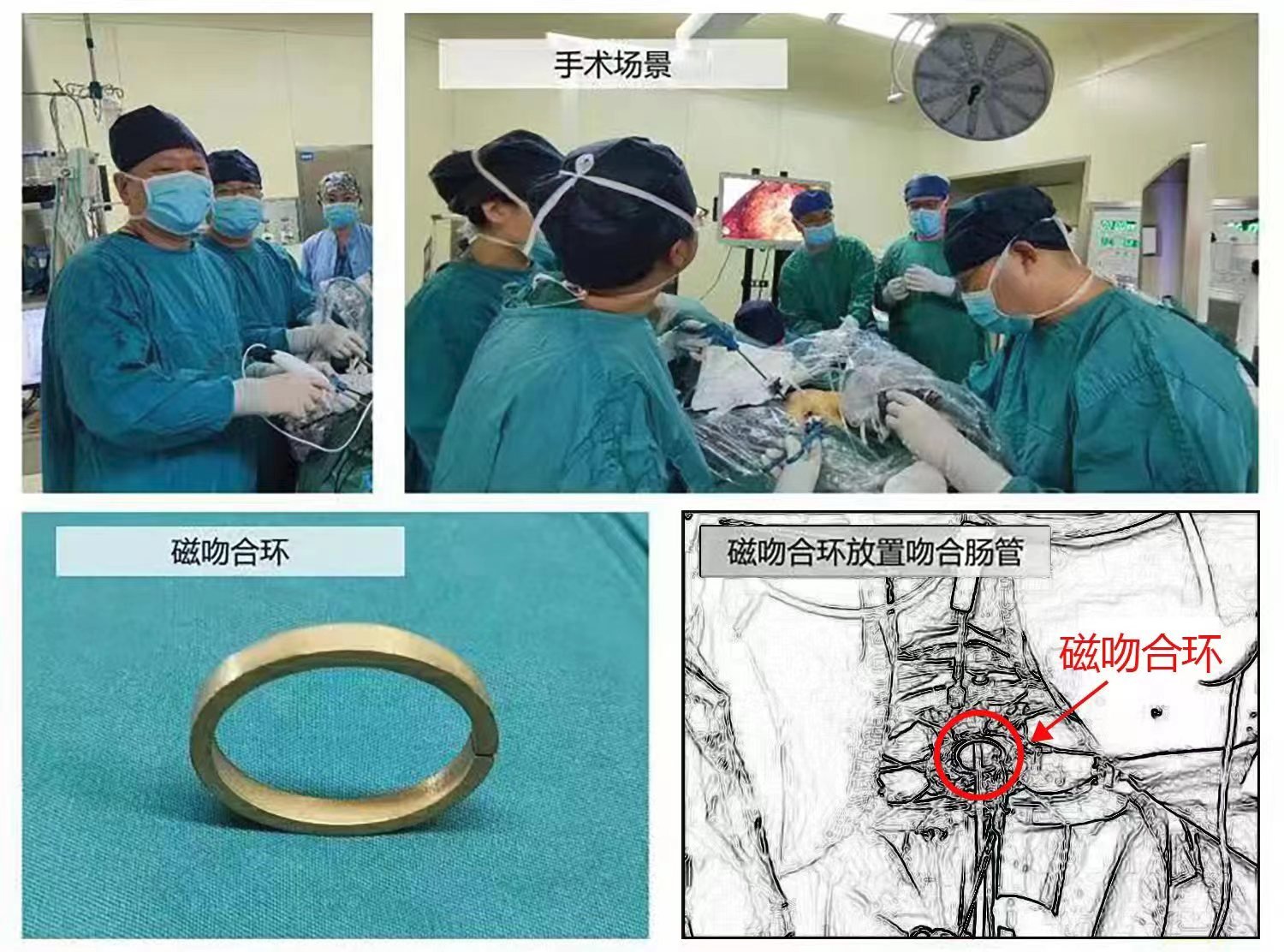Correspondent: Guo Huiting and Wang Xin
Recently, the General Surgery Department of the First Affiliated Hospital of Xi’an Jiaotong University cooperated with Surgical Dream Workshop to successfully implement the “transanorectal” Magnetic compression anastomosis for total mesentery excision”, which not only guarantees the effect of tumor resection, but also relieves the problems of anastomotic stenosis, bleeding and foreign bodies of intestinal anastomosis material for life. Searched by an authoritative novelty search agency, this operation is the first in the world.

60-year-old female patient Zhang came to the East Branch of the First Affiliated Hospital of Xi’an Jiaotong University for treatment because of “blood in the stool for 20 days”. Colonoscopy showed that there was a 4×5cm mass in the rectum about 5cm away from the anus, and the pathological biopsy showed rectal cancer. Prof. Fan Lin of General Surgery and the team of Deputy Chief Physician Li Xuqi, who is in charge of General Surgery of the East Branch, carefully studied the surgical plan, and cooperated with the magnetic surgery team led by Prof. Lv Yi to perform “transanorectal total mesorectal excision taTME” for patients with low rectal cancer. Magnetic Compression Anastomosis”.
The operation was supported and coordinated by Director Gao Wei and Head Nurse Gao Qing of the Department of Anesthesiology of the East Hospital. The operating room was equipped with double laparoscopes to work at the same time. Laparoscopic transabdominal dissociation of the rectum and mesentery to the pelvic floor; in the transanal surgery group, a second surgical field was established at the anus through an anal retractor and a single-port laparoscopic port, the lower tumor margin was determined under direct vision, and the rectum was severed. The “bottom-up” method was retrograde to free the pelvis and merged with the abdominal surgery group; the specimen was pulled out from the anus, the rectum was cut off at 10 cm above the tumor’s upper edge, the first magnetic anastomotic ring was placed in the proximal rectum, and the intestinal stump was embedded in the purse. ; The distal rectal stump is closed by purse-string suture through the anus, and a second magnetic compression anastomosis ring is inserted; the proximal rectum and the distal rectum are anastomosed by the magnetic adsorption of the two magnetic compression anastomotic rings.

Associate Professor Zhu Shuai of the Department of Anesthesiology, Dr. Bai Jing escorted during the operation, and surgical nurse Chen Shuhua , Mr. Gao Chunni and the medical team cooperated tacitly, and Prof. Fan Lin of General Surgery, Deputy Chief Physician Li Xuqi, Chief Physician Yang Kui, Liu Wenqi, Wei Xingxing, and Physicians Xu Yubao cooperated with each other to successfully complete the surgical process, and the rectal magnetic anastomosis did not take much time. to 10 minutes. The patient recovered smoothly after operation. Part of the intestinal wall sandwiched between the two magnetic rings was gradually necrotic due to compression and ischemia, and the intestinal walls around the magnetic ring were gradually healed together. On the 11th postoperative day, the magnetic anastomotic rings that were adsorbed together fell off together with the necrotic intestinal wall squeezed between the two rings, and were subsequently discharged from the anus. On the 20th day after the operation, associate professor Ren Mudan, director of the Department of Gastroenterology in the East Campus, performed a colonoscopy, which showed that the rectal anastomosis was wide and smooth, the intestinal wall was intact, and no foreign body remained; Associate Professor Jin Chenwang, director of the Imaging Department of the East Campus, and Dr. CT virtual colonoscopy imaging was performed, and the intestinal canal was intact and unobstructed, and there was no abnormality in the surrounding tissues of the anastomosis. The patient was very satisfied with the results of the surgery.

This case of low rectal cancer underwent total anorectal mesorectal excision and rectal end-to-end magnetic compression anastomosis Compared with the current laparoscopic surgery, it has significant advantages:
First, on the basis of ensuring radical tumor resection, it further realizes the unity of minimally invasive and aesthetic effects, and there is no traditional abdominal surgery. Surgical incision, while reducing trauma and promoting rapid recovery;
Secondly, this operation is more advantageous for dissecting the free low rectum and mesentery, improving the low rectum in the “difficult pelvis” The quality of surgical resection of cancer patients;
Thirdly, it is conducive to the realization of sphincter preservation for low rectal cancer, and more importantly, it ensures the integrity of postoperative anal function;
Fourth, the magnetic compression anastomosis is a wireless sutured intestinal anastomosis, which avoids the easy dehiscence of the surrounding tissue of the anastomotic stoma caused by the intestinal anastomosis caused by the gastrointestinal stapler, and the surrounding tissue of the anastomotic stoma is easily Defects of bleeding, anastomotic obstruction and incomplete suture; Or foreign bodies such as titanium nails will remain in the human body, causing inconvenience and discomfort, and improving the quality of life after surgery; The time is short, the operation time is reduced, and the patient recovers quickly after the operation;
Seventh, the magnetic anastomotic ring has a simple structure and can be reused after repeated disinfection, and the cost of medical treatment is relatively high. Stapled intestinal anastomosis is greatly reduced.
This case of rectal cancer“transanorectal total mesorectal excision and magnetic compression anastomosis”successfully implemented, is the president of the First Affiliated Hospital of Jiaotong University, Professor Lv Yi, director of the National and Local Joint Engineering Research Center for Precision Surgery and Regenerative Medicine, actively advocated and promoted the first clinical application of the cutting-edge new technology combining medicine and engineering combined with magnetic pressing in rectal cancer surgery. important breakthrough. At the same time, the operation was successfully completed in the East Campus of the First Affiliated Hospital of Jiaotong University, which is also an important manifestation of the homogeneous development of the two hospitals.